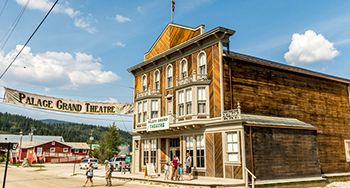Tr’ondëk-Klondike, Yukon
Yukon
Date of inscription : 2023
Tr’ondëk-Klondike is located in the subarctic region of northwest Canada in Canada’s Yukon Territory and the homeland of the Tr’ondëk Hwëch’in, an Indigenous people that has lived in the region for thousands of years. Tr’ondëk-Klondike is a serial cultural property made up of 8 components that, collectively, represent one of the most complete and exceptional ensembles of archaeological and historic evidence that reflects an Indigenous people’s experience of and adaptation to the global phenomenon known as European colonialism. It tells the story of different phases of the relationship between Tr’ondëk Hwëch’in and newcomers to their traditional territory from 1874 to 1908.

Justification of Outstanding Universal Value
Tr’ondëk-Klondike was inscribed on the World Heritage List by the World Heritage Committee under the following criteria:
Criterion (iv): Tr’ondëk-Klondike includes archaeological immovable remains, built structures and settlement patterns that illustrate the dramatic encounter triggered by the feverish search for precious metals between the Indigenous population and outsiders in a sub-arctic region, the colonial affirmation of the latter over the lands, resources and people, and the Indigenous people’s response to these events, in the late 19th century. Tr’ondëk-Klondike stands out as a very rare occurrence and provides remarkable evidence of growing colonial influence within a concentrated timeframe – from the construction of the first commercial fur-trading post at Fort Reliance in 1874, to the Klondike Gold Rush of 1896-1898, and, ultimately, the consolidation of colonial authority by 1908.
Full description
Centered on the Yukon and Klondike rivers in the northwestern part of Canada, Tr’ondëk-Klondike is a living cultural landscape that bears witness to the long-standing coexistence of the Tr’ondëk Hwëch’in and the newcomers who found themselves linked to each other by the famous gold rush of the 19th century. The Klondike Gold Rush took place between 1896 and 1898 and caused approximately 30,000 people from all over the world to head to the Klondike in hopes of finding gold there. Located in a harsh subarctic environment, the designated area includes a wide range of heritage attributes along an 85 km stretch of the Yukon River, in the gold rush town of Dawson City and in the Klondike Goldfields.
There are Indigenous sites, camps, and settlements such as Tr’ochëk Fishing Camp and Moosehide Village; the plans, streetscapes and vernacular buildings of Dawson City, as well as the topography, infrastructure, machinery and enclosures characteristic of more than a century of continuous placer mining in the gold fields.
The fundamentally different relationships with the land for the Tr’ondëk Hwëch’in and newcomer populations continue to shape the cultural landscape today. Traditional Indigenous culture and values coexist with active placer mining in an area that has long been associated with a frontier meeting place of Indigenous peoples and newcomers in search of land and resources. This context and the enormous impact of the Gold Rush and its aftermath are legible in the material heritage of the landscape. They are also evocatively portrayed in a rich body of literature and photography as well as narrated in the stories of the Tr’ondëk Hwëch’in. Ultimately, the site is a distinctive, intact, and comprehensive example of a nineteenth-century gold rush whose legacy has shaped the region and its inhabitants for the past 120 years.
The development of the nomination was led by the Tr’ondëk Hwëch’in in collaboration with the Government of Yukon, Parks Canada, and with continued support from the Government of Canada. It also benefited from consultations with Canadian and international experts and the upstream advice of ICOMOS.
Related links
- Anticosti, Quebec
- Writing-on-Stone / Áísínai’pi
- L’Anse aux Meadows National Historic Site
- Nahanni National Park Reserve
- Dinosaur Provincial Park
- Kluane / Wrangell-St.Elias / Glacier Bay /...
- Head-Smashed-In Buffalo Jump
- SG̱ang Gwaay
- Wood Buffalo National Park
- Canadian Rocky Mountain Parks
- Historic District of Old Québec
- Gros Morne National Park
- Old Town Lunenburg
- Waterton-Glacier International Peace Park
- Miguasha National Park
- Rideau Canal
- Joggins Fossil Cliffs
- Landscape of Grand Pré
- Red Bay Basque Whaling Station
- Mistaken Point
- Pimachiowin Aki
- Date modified :